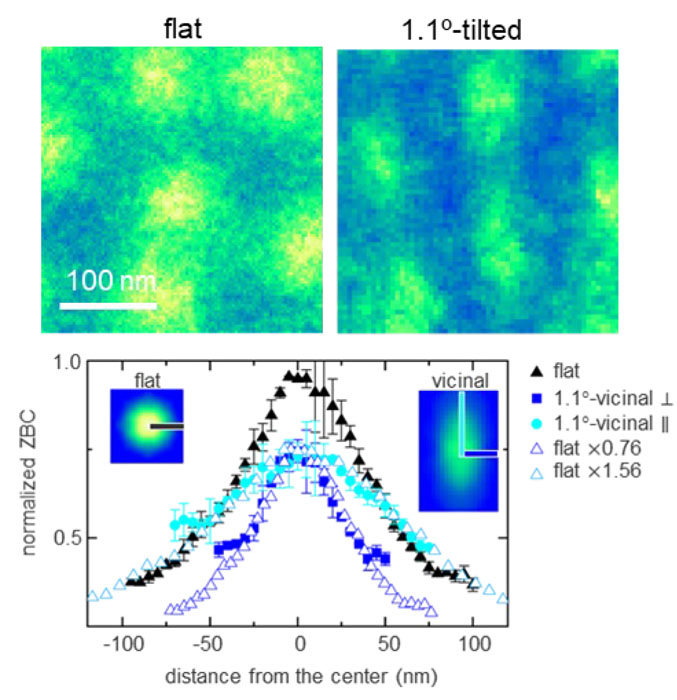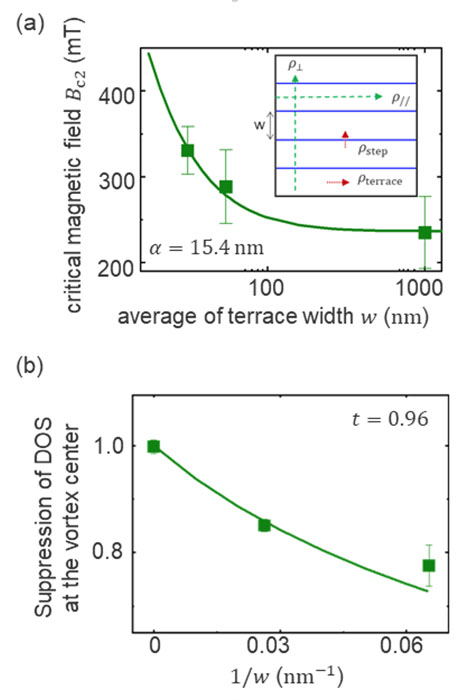Squeezed Abrikosov-Josephson Vortex
Hasegawa Group
Two-dimensional (2D) superconductors are sensitive to the presence of disorder, which induces electron localization, phase fluctuation, and eventually the superconducting-insulator transition at zero temperature. Here we present a new way of introducing disorder into high-quality monolayer superconductors by forming them on vicinal substrates. We fabricated the striped incommensurate (SIC) structure, one of the Pb monolayer superconducting phases, on vicinal Si(111) substrates tilted by 1.1° or 0.5°. Since each step works as a disorder and behaves like a Josephson junction, by just adjusting the miscut angle, the step separation, or disorder density, can be controlled precisely.
The role of a single step on atomic-layer superconductors has been investigated by scanning tunneling microscopy (STM) [1]. The shape of vortex cores trapped at steps depends on how the step decouples the superconducting terraces. When the decoupling is weak, round Abrikosov vortex is pinned at the step. With the intermediate decoupling, trapped vortices are elongated along the step, which is called a Abrikosov-Josephson vortex (AJV) and their local density of states (DOS) within the gap is not fully recovered at the core. In the case of the strongly decoupling step, a further elongated vortex with local DOS almost same as that of superconducting states, that is, Josephson vortex, is formed along the step.
Through the electron transport measurement under out-of-plane magnetic fields B, we found that the critical magnetic field (Bc2) of the superconducting phase formed on vicinal substrates is higher than that formed on the flat substrate. Using STM at 0.36 K, we estimated Bc2 from the magnetic field that saturates the conductance at the bottom of the superconducting gap, that is, zero bias conductance (ZBC), and found consistent with those of the transport measurements.
In order to understand the enhanced Bc2 microscopically, we investigated vortices by STM. The upper panels of Fig. 1 are ZBC maps showing the vortices taken on the flat and 1.1°-tilted SIC sample under B = 120 mT. Compared with the round vortices observed on the flat sample, the vortices on the tilted sample are elongated along the step direction. In addition, ZBC at the center is suppressed. Since both are characteristic features of AJV we attribute them to an AJV.
According to the Ginzburg-Landau (GL) equation, the critical field is inversely proportional to ξ2. Since the size of vortex is closely related to ξ, we investigated the size and shape of the vortices. The lower panel of Figure 1 shows the ZBC cross-sectional profiles taken on vortices on the flat sample (black triangles), on the vicinal sample in the directions parallel (//, light blue circles) and perpendicular (⊥, blue squares) to the steps. From the plot we found that these three profiles have a similar shape. First, on the vortices of the vicinal sample, ZBC at the center is suppressed by a factor of 0.78. Then, the suppressed profile was laterally expanded by a factor of 1.56 (shrunk by 0.76) to find good agreements with the parallel (perpendicular) profiles of the vicinal sample’s vortices.

Fig. 1. (upper panels) ZBC maps taken on flat and 1.1°-tilted vicinal SIC samples showing vortices under out-of-plane magnetic field of 120 mT. (lower panel) ZBC profiles across the vortex center taken on the flat (black triangles) and the vicinal (blue squares and light blue circles) samples, respectively. Blue squares (light blue circles) indicate the profiles taken in the direction perpendicular (parallel) to the steps. Empty blue (light blue) triangles are the profile taken on the vortices of the flat sample multiplied by 0.78 in height and by 1.56 (0.76) along the horizontal axis, demonstrating similarity in the three profiles. Insets show the averaged vortices taken on the flat and vicinal samples.
Curiously, the squeezing ratio in the perpendicular direction, 0.76, corresponds well to the inverse of the Bc2 enhancement ratio (Bc2,flat/Bc2,vicinal). According to the anisotropic 2D GL model, Bc2,vicinal is given by Φ0/2πξ⊥ξ//, where ξ⊥ and ξ// are the coherence length in the directions perpendicular and parallel to the steps. Thereby the correspondence suggests us that the Bc2 enhancement is due to the reduced coherence length ξ⊥ by the presence of the steps.
The reduction in ξ by the high-density steps is explained by the suppression of mean free path l by disorder according to the equation ξ = √−ξ0l, where ξ0 is the coherence length without disorder. Since l is written as h/e2kFρ for a 2D system, where ρ is the resistivity, in a 2D metallic layer with an array of linear resistors at equal interval w as shown in the inset of Fig. 2(a), we found Bc2.vicinal/Bc2.flat is written as (1 + α/w)-1/2, where α ≡ ρstep/ρterrace is a ratio of step and terrace resistivity. Figure 2(a) shows Bc2 dependence on the terrace width w obtained from our experimental results including those of 0.5°-tilted vicinal sample. A solid curve is a fitted one with α = 15.4 nm, showing good agreement. Since lflat ~ 3.3 nm we estimates l⊥ for 1.1° (0.5°) -tilted vicinal SIC phases is 1.6 (2.3) nm, respectively.

Fig. 2. (a) Terrace width dependence of the critical magnetic field. The solid curve is a fitting described in the text. The inset shows a schematic of the arrayed resistors to model the vicinal SIC phases. (b) terrace width dependence of the suppressed DOS at the vortex center. The solid curve is a fitting written in the text.
One of the characteristic features of AJV is the suppression of DOS within the gap at the vortex core. According to the calculations of AJV [1], the DOS suppression is described as t2, where t is the ratio of hopping strength across the step to that within the terrace. Since the width of the elongated vortex core is given by 2ξ⊥, vortices on the vicinal substrates cross the steps 2ξ⊥/w times. The effective hopping strength ratio across the steps is thus given as t2ξ⊥/w. Figure 2(b) shows the terrace width dependence of the suppression factor t4ξ⊥/w. A solid green curve is a fitting one with ξ⊥ = ξflat (1 + α/w)-1/2, showing a good agreement when t = 0.96. Considering an almost round shape of vortices trapped at a single step of the same SIC phase [1], the estimated value close to 1 is reasonable. We thus conclude that the elongated vortices observed on the vicinal samples are due to the formation of AJV. They are, however, different from ones formed on a single step that have the width of the coherence length. In the vicinal SIC phases, AJV are squeezed in the direction perpendicular to the steps because of the limited mean free path in the direction.
References
- [1] S. Yoshizawa et al., Phys. Rev. Lett. 113, 247004 (2014).
